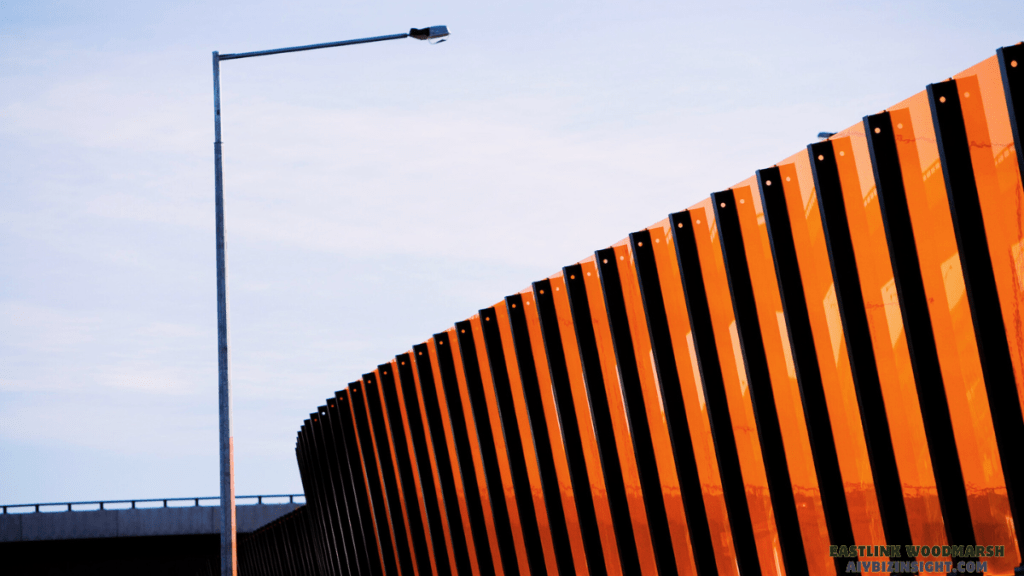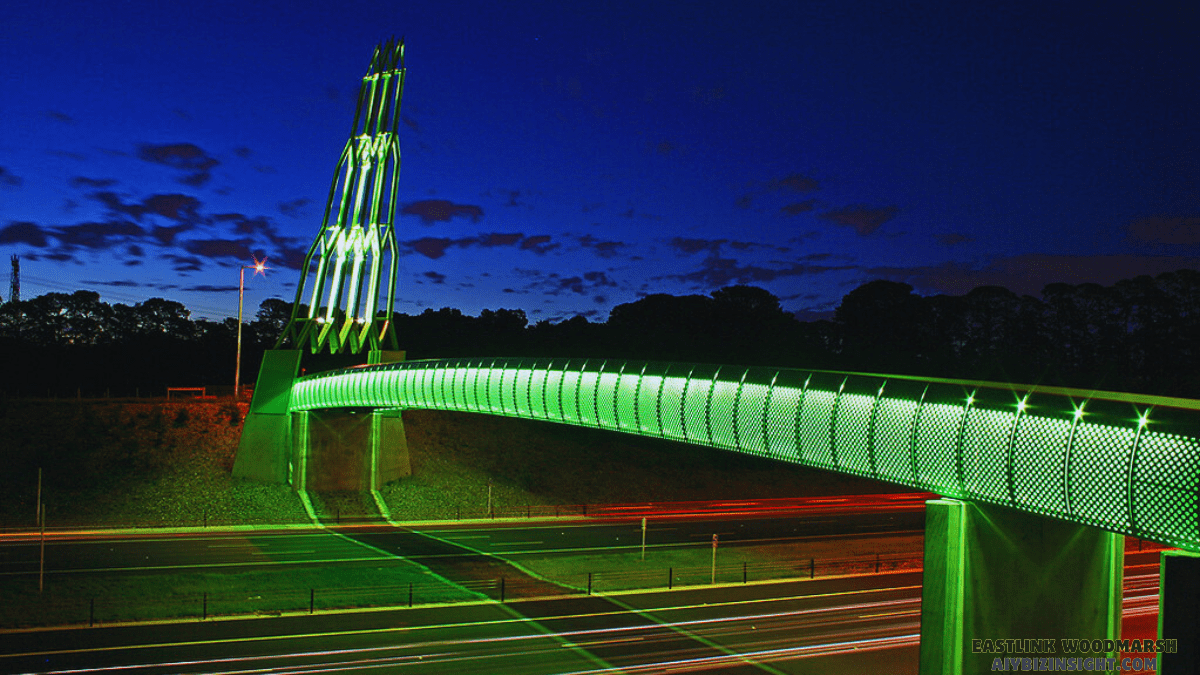1. Introduction to Eastlink Woodmarsh
The Eastlink Freeway, stretching over 45 kilometers from Melbourne’s Eastern Freeway to Frankston, has transformed the region’s transport landscape by enhancing connectivity and reducing congestion. With Melbourne’s rapid urban growth, Eastlink Woodmarsh addresses the pressing need for efficient, sustainable transport infrastructure that can serve high commuter volumes while harmonizing with its surroundings. A standout feature of this project is the architectural concept developed by Wood Marsh, whose designs bridge urban landscapes and natural scenery.
Project Vision
Wood Marsh approached the Eastlink project with a vision that emphasized function, modern aesthetics, and environmental harmony. Tasked with crafting the freeway’s architectural identity, Wood Marsh’s vision was to create an infrastructure piece that went beyond utilitarian purposes and embodied artistic expression. Each design element—whether curves, textures, or colors—was selected to integrate with the local terrain, transforming the freeway into an artwork that commuters experience daily. This vision reinforces Eastlink’s role not just as a freeway, but as a reflection of Melbourne’s progressive architectural landscape.
2. Role of Wood Marsh in the Eastlink Project
Architectural Contributions
Wood Marsh’s scope of work on the Eastlink project included creating detailed design concepts, architectural documentation, onsite detailing, and aesthetic inspections. Their approach extended beyond functionality; Wood Marsh emphasized aesthetic qualities that transformed bridges, sound walls, and overpasses into architectural statements. Unique design elements, such as sculptural sound walls and creative underpasses, showcase how the freeway can coexist within an urban fabric, adding beauty to daily commutes.
Collaboration with Thiess-John Holland
As part of a consortium led by Thiess-John Holland, Wood Marsh played a crucial role in turning these ambitious designs into reality. The collaboration ensured a seamless transition from concept to construction, with each entity focusing on technical precision, durability, and sustainability. This partnership allowed Wood Marsh to maintain its creative vision while Thiess-John Holland ensured technical robustness, resulting in a freeway that is both structurally sound and visually impressive.
3. Architectural Innovation in Eastlink Woodmarsh
Signature Design Elements
Wood Marsh introduced unique architectural elements along the freeway, including sound walls featuring textured surfaces and sculptural forms inspired by the surrounding landscape. These walls are not just functional—they mitigate noise pollution—but also artistic, offering a modern aesthetic that contrasts and complements natural surroundings. Large, abstract shapes and color schemes add character, making Eastlink a distinctive visual experience within Melbourne’s infrastructure network.
Harmonizing Urban and Natural Elements
The design of Eastlink Woodmarsh goes beyond blending materials and shapes; it respects and adapts to the natural landscape. For example, road alignments are carefully placed to follow the terrain, reducing environmental disruptions and enhancing visual continuity. This strategic placement of structures allows the freeway to feel as though it belongs within the landscape, rather than overpowering it and creates an organic visual flow that commuters and locals appreciate.
Visual Impact and Artistic Expression
Eastlink Woodmarsh also serves as public art, giving residents a freeway that embodies artistic expression. Commuters experience unique visual elements, such as the large-scale sculptures by artists like Emily Floyd’s “Public Art Strategy” sculptures, which add cultural value and regional identity to the infrastructure. Eastlink’s aesthetic and artistic integration has led it to be recognized as one of the world’s most innovative freeway projects, with its design influencing both the architectural and urban design fields.

4. Sustainability at the Core
Eco-friendly Materials and Techniques
Wood Marsh prioritized eco-conscious materials in constructing Eastlink, using sustainable concrete blends, recycled materials, and low-impact techniques where possible. Techniques included noise barriers made with recycled materials, and sustainably sourced stone and concrete. These choices significantly reduce the freeway’s carbon footprint and support the goal of creating infrastructure that is both functional and environmentally responsible.
Environmental Impact Considerations
The project team conducted extensive environmental assessments to ensure the freeway’s layout preserved existing habitats and respected local ecosystems. Measures like controlled water runoff systems were implemented to protect nearby waterways from contamination. The project’s sustainable approach minimizes its ecological footprint while providing long-term environmental benefits, contributing to biodiversity conservation.
Long-term Benefits
The Eastlink design supports long-term ecological preservation, promoting reduced emissions through better traffic flow and congestion management. The freeway’s integration of eco-friendly materials and landscape-sensitive structures ensures it will continue to serve as a positive example of sustainable urban infrastructure. Its legacy lies in demonstrating that large-scale infrastructure can be both environmentally supportive and aesthetically compelling.
5. Eastlink Woodmarsh’s Influence on Modern Urban Planning
Integration with Urban Planning Goals
Eastlink is a prime example of modern urban planning, designed to alleviate traffic congestion while providing a balanced connection between expanding urban and suburban areas. It not only improves the commuter experience but also helps manage urban sprawl by creating defined routes for growth. Eastlink’s design aligns with urban planning goals by making commuting more efficient and safer, while also contributing positively to the urban landscape.
Inspiration for Future Projects
The success of Eastlink Woodmarsh has set a precedent for future infrastructure projects worldwide. It serves as a case study for how architectural aesthetics can coexist with practical functionality and environmental preservation. As cities continue to expand, Eastlink offers an inspiring model for integrating beauty and sustainability in infrastructure, making it a landmark that bridges architecture with urban planning principles.
6. Public and Expert Reception
Community and Visitor Responses
Local communities and commuters have praised Eastlink Woodmarsh for its efficiency, scenic design, and artistic elements that add meaning to everyday commutes. Feedback often highlights the refreshing aesthetic, with commuters noting how the art and design elements uplift the traditional freeway experience, fostering a sense of pride and ownership among locals.
Expert Opinions and Awards
Architectural experts, urban planners, and sustainability advocates have acknowledged Eastlink’s architectural and ecological contributions. The project has received multiple awards, including national design accolades, recognizing it as a benchmark for freeway design. Experts often reference Eastlink Woodmarsh as a model for integrating sustainability, aesthetics, and functionality in large-scale infrastructure.
7. Legacy and Future of Eastlink Woodmarsh
Continued Relevance
Eastlink Woodmarsh remains a relevant example of modern freeway design and urban planning. Its approach to sustainability, environmental sensitivity, and artistic expression continues to influence contemporary architectural practices. This legacy is particularly important as cities worldwide adopt green infrastructure to mitigate environmental impact.
Prospects for Future Enhancements
The Eastlink project has the potential for upgrades, especially with advancements in eco-friendly materials and renewable energy sources. Future enhancements could include solar-powered infrastructure or adaptive traffic systems to further reduce environmental impact. These updates would enhance Eastlink’s role as a beacon of sustainable, aesthetically driven infrastructure, maintaining its status as a model for progressive urban design.

8. Conclusion
Summary
Eastlink Woodmarsh has set a new standard in freeway design, seamlessly blending function, art, and environmental stewardship. This infrastructure is not just about improving traffic flow; it’s a statement on creating public spaces that prioritize sustainability and aesthetics.
Lasting Impact
Eastlink Woodmarsh continues to inspire future projects, proving that infrastructure can be both beautiful and sustainable. Its legacy is a testament to Wood Marsh’s innovative design, reminding us of architecture’s potential to responsibly enhance urban environments.
FAQs
1. What makes Eastlink Woodmarsh unique among freeway projects?
Eastlink Woodmarsh stands out for its seamless integration of art, sustainability, and modern infrastructure. Unlike traditional freeways, it combines functional traffic management with striking architectural design, including sculptures and aesthetic sound barriers, while prioritizing eco-friendly materials and environmental preservation. This approach positions Eastlink as a global model for freeway projects that blend practicality with artistic and environmental considerations.
2. How does Eastlink Woodmarsh contribute to sustainability?
Eastlink Woodmarsh incorporates sustainable practices at every stage. From using recycled and eco-friendly materials to designing roadways that minimize ecological disruption. Measures such as water runoff control systems, habitat preservation efforts, and a low carbon footprint approach make Eastlink not only functional but also environmentally supportive, creating a freeway that’s as green as it is efficient.
3. What has been the public and expert response to Eastlink Woodmarsh?
The public appreciates Eastlink Woodmarsh for transforming everyday commutes into an engaging experience, with artistic structures that beautify the journey. Experts in architecture and urban planning have also lauded the project. Recognized it with several awards for its innovative design, sustainability, and success in setting a benchmark for future urban infrastructure projects that harmonize function with visual appeal.
